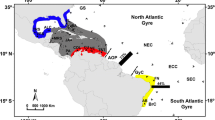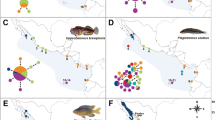Abstract
Pelagic larval duration (PLD) is a commonly used proxy for dispersal potential in coral reef fishes. Here we examine the relationship between PLD, genetic structure and genetic variability in geographically widespread and ecological generalist species from one coral reef fish family (Pomacentridae) that differs in mean larval duration by more than a month. The genetic structure was estimated in eight species using a mitochondrial molecular marker (D-loop) and in a sub-set of five species using nuclear molecular markers (ISSRs). Estimates of genetic differentiation were similar among species with pelagic larvae, but differed between molecular markers. The mtDNA indicated no structure in all species except one, while the ISSR indicated some structure between the sampling locations in all species. We detected a relationship between PLD and genetic structure using both markers. These relationships, however, were caused by a single species, Acanthochromis polyacanthus, which differs from all the other species examined here in lacking a larval phase. With this species excluded, there was no relationship between PLD and genetic structure using either marker despite a range of PLDs of more than 20 days. Genetic diversities were generally high in all species and did not differ significantly among species and locations. Nucleotide diversity and total heterozygosity were negatively related to maximum PLD but again these relationships were caused by A. polyacanthus and disappeared when this species was excluded. These genetic patterns are consistent with moderate gene flow among well-connected locations and indicate that at this phylogenetic level (i.e., within family) the duration of the pelagic larval phase is unrelated to the patterns of genetic differentiation.




Similar content being viewed by others
References
Arndt A, Smith MJ (1998) Genetic diversity and population structure in two species of sea cucumber: differing patterns according to mode of development. Mol Ecol 7:1053–1064
Avise JC (2000) Phylogeography. The history and formation of species. Harvard University Press, Cambridge
Ayre DJ, Hughes TP (2000) Genotypic diversity and gene flow in brooding and spawning corals along the Great Barrier Reef, Australia. Evolution 54:1590–1605
Barber PH, Palumbi SR, Erdmann MV, Moosa MK (2000) Biogeography: a marine Walllace’s line? Nature 406:692–693
Bay LK, Choat JH, van Herwerden L, Robertson DR (2004) High genetic diversities and complex genetic structure in an Indo-Pacific tropical reef fish (Chlorurus sordidus): evidence of an unstable evolutionary past? Mar Biol 144:757–767
Bay K, Buechler K, Gagliano M, Caley MJ (2006) Intraspecific variation in the pelagic larval duration of tropical reef fishes. J Fish Biol (in press)
Bernardi G (2000) Barriers to gene flow in Embiotoca jacksoni, a marine fish lacking a pelagic larval stage. Evolution 54:226–237
Bernardi G, Holbrook SJ, Schmitt RJ, Crane NL, Edward D (2002) Species boundaries, populations and colour morphs in the coral reef three-spot damselfish (Dascyllus trimaculatus) species complex. Proc Royal Soc Lond B 269:599–605
Bohonak AJ (1999) Dispersal, gene flow, and population structure. Q Rev Biol 74:21–45
Bonhomme F, Planes S (2000) Some evolutionary arguments about what maintains the pelagic interval in reef fishes. Environ Biol Fishes 59:365–383
Bornet B, Branchard M (2001) Nonanchored inter simple sequence repeat (ISSR) markers: Reproducible and specific tools for genome fingerprinting. Plant Mol Biol Rep 19:209–215
Clarke A, Saether B, Roskaft E (1997) Sex biases in avian dispersal: a reappraisal. Oikos 79:429–348
Doherty PJ, Mather P, Planes S (1994) Acanthochromic polyacanthus, a fish lacking larval dispersal, has genetically differentiated populations at local and regional scales on the Great Barrier Reef. Mar Biol 121:11–21
Doherty PJ, Planes S, Mather P (1995) Gene flow and larval duration in seven species of fish from the Great Barrier Reef. Ecology 76:2373–2391
Fauvelot C, Bernardi G, Planes S (2003) Reductions in the mitochondrial DNA diversity of coral reef fish provide evidence of population bottlenecks resulting from Holocene sea-level change. Evolution 57:1571–1583
Fishelson L (1998) Behaviour, socio-ecology and sexuality in damselfishes (Pomacentridae). Ital J Zool 65:387–398
Fisher R (2005) Swimming speeds of larval coral reef fishes: impacts on self-recruitment and dispersal. Mar Ecol Prog Ser 285:223–232
Fraser DJ, Lippe C, Bernatchez L (2004) Consequences of unequal population size, asymmetric gene flow and sex-biased dispersal on population structure in brook charr (Salvelinus fontinalis). Mol Ecol 13:67–80
Godwin JR, Thomas P (1993) Sex change and steroid profiles in the protandrous anemonefish Amphiprion melanopus (Pomacentridae, Teleostei). Gen Comp Endocrin 91:144–157
Greenwood P (1980) Mating systems, philopatry and dispersal in birds and mammals. Anim Behav 28:1140–1162
Hedgecock D (1986) Is gene flow from pelagic dispersal important in the adaptation and evolution of marine invertebrates? Bull Mar Sci 39:550–564
Hellberg ME (1996) Dependence of gene flow on geographic distance in two solitary corals with different larval dispersal capabilities. Evolution 50:1167–1175
Hellberg ME, Burton RS, Neigel JE, Palumbi SR (2002) Genetic assesment of connectivity among marine populations. Bull Mar Sci 70:273–290
van Herwerden L, Doherty PJ (2006) Contrasting genetic structures across two hybrid zones of a tropical reef fish, Acanthochromis polyacanthus (Bleeker 1855). J Evol Biol (in press)
Hunt A (1993) Effects of contrasting patterns of larval dispersal on the genetic connectedness of local populations of two intertidal starfish, Patriella clacar and P. exigua. Mar Ecol Prog Ser 92:179–186
Hutchings JA, Gerber L (2002) Sex-biased dispersal in a salmonid fish. Proc Royal Soc Lond B 269:2487–2493
Jones GP, Milicich MJ, Emslie MJ, Lunow C (1999) Self-recruitment in a coral reef fish population. Nature 402:802–804
Kavanagh KD (2000) Larval brooding in the marine damselfish Acanthochromis polyacanthus (Pomacentridae) is correlated with highly divergent morphology, ontogeny and life-history traits. Bull Mar Sci 66:321–337
Lee W, Conroy J, Howell W, Kocher TD (1995) Structure and evolution of teleost mitochondrial control regions. J Mol Evol 41:54–66
Leis JM (1991) The pelagic stage of reef fishes: the larval biology of coral reef fishes. In: Sale PF (ed) The ecology of fishes on coral reefs. Academic, San Diego, pp 183–230
Leis JM (2002) Pacific coral-reef fishes: the implications of behaviour and ecology of larvae for biodiversity and conservation, and a reassessment of the open population paradigm. Environ Biol Fishes 65:199–208
Lynch M, Milligan BG (1994) Analysis of population genetic structure with RAPD markers. Mol Ecol 3:91–99
Messmer V, van Herwerden L, Munday PL, Jones GP (2006) Phylogeography of colour polymorphism in the coral reef fish, Pseudochromis fuscus, from Papua New Guinea and the Great Barrier Reef. Coral Reefs (in press)
Mossman CA, Waser PM (1999) Genetic detection of sex-biased dispersal. Mol Ecol 8:1063–1067
Munday PL, van Herwerden L, Dudgeon CL (2004) Evidence for sympatric speciation by host shift in the sea. Curr Biol 14:1498–1504
Murdoch J (1995) Variability in the early life history of coral reef fishes., James Cook University. MSc Thesis. Marine Biology and Aquaculture, Townsville
Nei M (1987) Molecular evolutionary genetics. Colombia University Press, New York
Palumbi SR (2004) Marine reserves and ocean neighborhoods: the spatial scale of marine populations and their management. Annu Rev Environ Resc 29:31–68
Palumbi SR, Gaines SD, Leslie H, Warner RR (2003) New wave: high-tech tools to help marine reserve research. Front Ecol Environ 1:73–79
Peakall R, Smouse PE (2001) GenALEx V5: Genetic analysis in Excel. Population genetic software for teaching and research. Australian National University, Canberra, Australia. http://www.anu.au/BoZo/GenALEx/
Planes S, Parroni M, Chauvet C (1998) Evidence of limited gene flow in three species of coral reef fishes in the lagoon of New Caledonia. Mar Biol 130:361–368
Planes S, Doherty PJ, Bernardi G (2001) Strong genetic divergence among populations of a marine fish with limited dispersal, Acanthochromis polyacanthus, within the Great Barrier Reef and the Coral Sea. Evolution 55:2263–2273
Posada D, Crandall KA (1998) Modeltest: testing the model of DNA substitution. Bioinformatics 14:817–818
Riginos C, Victor BC (2001) Larval spatial distribution and other early life-history characteristics predict genetic differentiation in eastern Pacific blennoid fishes. Proc R Soc Lond B 268:1931–1936
Rocha LA, Robertson DR, Roman J, Bowen BW (2005) Ecological speciation in tropical reef fishes. Proc R Soc Lond B 272:573–579
Sambrook J, Russell D (2001) Molecular cloning. A laboratory manual. Cold Spring Harbor Laboratory Press, Cold Spring Harbor
Schneider S, Roessli D, Excoffier L (2000) Arlequin: A software for population genetics data analysis. Ver 2.000. Genetics and Biometry Lab, Department of Anthropology, University of Geneva
Shulman MJ (1998) What can population genetics tell us about dispersal and biogeographic history of coral-reef fishes? Aust J Ecol 23:216–225
Shulman MJ, Bermingham E (1995) Early life histories, ocean currents, and the population genetics of caribbean reef fishes. Evolution 49:897–910
Sokal RR, Rohlf FJ (1995) Biometry. The principles and practice of statistics in biological research. W. H. Freeman and Company, New York
Stobutzki IC (1998) Interspecific variation in sustained swimming ability of late pelagic stage reef fish from two families (Pomacentridae and Chaetodontidae). Coral Reefs 17:111–119
Swearer S, Caselle J, Lea D, Warner R (1999) Larval retention and recruitment in an island population of a coral-reef fish. Nature 402:799–802
Swofford DL (1998) Phylogenetic analysis using parsimony (*and other methods). Version 4. Sinauers Associates, Sunderland
Tajima F (1983) Evolutionary relationship of DNA sequences in finite populations. Genetics 105:437–460
Taylor MS, Hellberg ME (2003) Genetic evidence for local retention of pelagic larval in a Caribbean reef fish. Science 299:107–109
Thorrold SR, Milicich MJ (1990) Comparison of larval duration and pre- and post-settlement growth in two species of damselfish, Chromis atripectoralis and Pomacentrus coelestis (Pisces: Pomacentridae), from the Great Barrier Reef. Mar Biol 105:375–384
Thresher RE, Colin PL, Bell LJ (1989) Planktonic duration, distribution and population structure of Western and Central Pacific damselfishes (Pomacentridae). Copeia 1989:420–434
Vekemans X, Beauwens T, Lemaire M, Roldan-Ruiz I (2002) Data from amplified fragment length polymorphism (AFLP) markers show indication of size homoplasy and of a relationship between degree of homoplasy and fragment size. Mol Ecol 11:139–151
Victor BC (1991) Settlement strategies and biogeography of reef fishes. In: Sale PF (ed) The ecology of fishes on coral reefs. Academic, San Diego, pp 231–260
Waples RS (1987) A multispecies approach to the analysis of gene flow in marine shore fishes. Evolution 41:385–400
Wellington GM, Victor BC (1989) Planktonic larval duration of one hundred species of Pacific and Atlantic damselfishes (Pomacentridae). Mar Biol 101:557–567
Wright S (1931) Evolution in Mendelian populations. Genetics 16:97–159
Zietkiewicz E, Rafalski A, Labuda D (1994) Genome fingerprinting by simple sequence repeat (SSR)-anchored polymerase chain reaction amplification. Genomics 20:176–183
Acknowledgements
We thank Michelle Waycott for extensive technical advise during ISSR development and screening. The staff at Lizard and One-Tree Island Research stations and numerous volunteers all made the field collections possible. Financial support was gained from James Cook University (LKB and RHC), the Australian Museum (LKB), Australian Coral Reef Society (LKB) and the Australian Research Council (RHC). Comments from three anonymous reviewers improved this manuscript. This study conformed to current Australian Law and was conducted under JCU Ethics and GBRMPA permits.
Author information
Authors and Affiliations
Corresponding author
Additional information
Communicated by M.S. Johnson
Rights and permissions
About this article
Cite this article
Bay, L.K., Crozier, R.H. & Caley, M.J. The relationship between population genetic structure and pelagic larval duration in coral reef fishes on the Great Barrier Reef. Mar Biol 149, 1247–1256 (2006). https://doi.org/10.1007/s00227-006-0276-6
Received:
Accepted:
Published:
Issue Date:
DOI: https://doi.org/10.1007/s00227-006-0276-6




